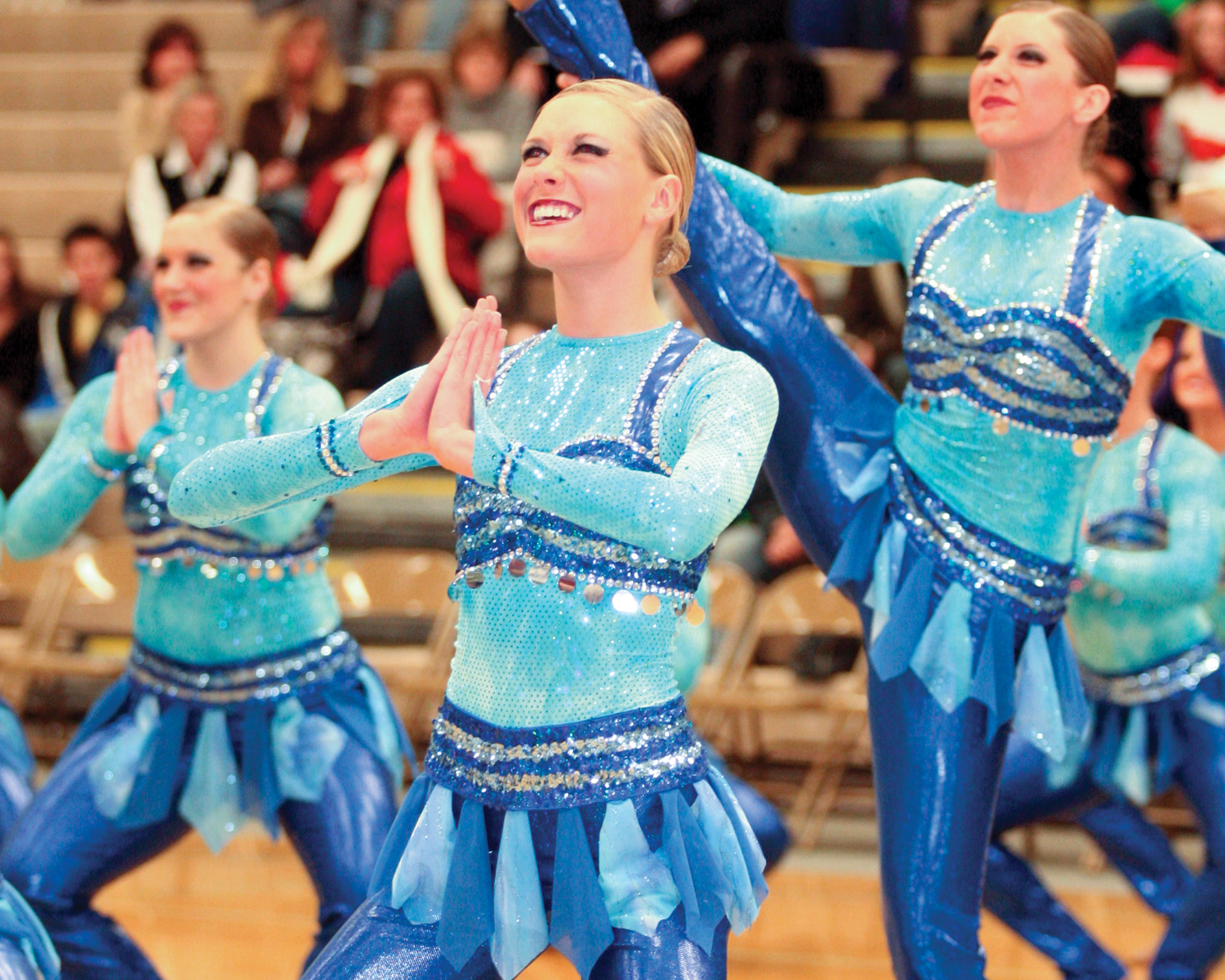
And, every year, you come up with a new themed performance set, requiring new costumes to fit your theme, right? An option should be to pull old costumes out of your closet and see if you can reimagine or renovate. Do this by changing the actual costume, or by adding accessories or additional pieces to the existing costume.
From Esther Williams to Bollywood
How do you renovate your past costumes to solve your current costume design requirements? At Satin Stitches, we have been tasked to do this and have had several successful renovations. We have transformed Esther Williams-style, 1940’s swim costumes into costumes that evoked a Bollywood theme.
How did we do it? We removed the bottom half of the costume (which was attached with one seam). Then we added a pair of long pants instead of the shorts, and we added a skirt. We also added silver paillettes (also referred to as spangles) as a trim for the faux bra-top. The basic leotard/top half of the costume remained as the original. The cost to refurbish this group costume was less than half of what the cost would have been to make a costume from scratch.
Another group costume had a policeman theme, with appliques suitable for a police uniform. We then removed those appliques and added vertical sequin stripes to give the illusion of a referee uniform.
Transforming costumes to something new and updated is most cost effective if new features are added rather than removed, as ripping generally takes longer to do than sewing, unless parts of the original costume can be cut off, rather than correctly, surgically removed.
Other Ways to Renovate Old Costumes
Other ways to renovate your old costumes is to add trim. Maybe you have a set of dresses that are pretty plain looking. The least expensive trim would be sequined by-the-yard trim. It looks great on stage, from performance distance. Otherwise we love to add rhinestones! Rhinestones can be added to most fabrics and in most areas of the costume. They involve hand placing and hand gluing, and generally take lots of time. Perhaps this is something that your parents could volunteer for. If not, we would be happy to do any rhinestoning or sequinning project that you may have.
Some people love to rhinestone and others aren’t so sure! Adding glitz to a costume can truly take the costume to the next level, or—if done poorly—it can detract from the overall look of the costume, not what you are trying to achieve.
First of all, you need to decide what type of rhinestones to use for your dance costume embellishment project. There are many different styles, qualities and colors. The best, most brilliant, highest quality (and—yes—most expensive) are Swarovski rhinestones— made in Austria, and Czechoslovakian rhinestones. There are several qualities of Czech stones and several rhinestone web sites that help to inform you on what makes a better stone. Do some research to learn more. The lesser expensive, Korean rhinestones are a much lower quality of rhinestone. The ones that I’ve seen are not nearly as brilliant, especially the colors, but they are still much better than the acrylic rhinestones. Acrylics are plastic and look plastic, thus generally should not be used.
Should I Set, Sew, Glue or Hot Fix My Rhinestones?
Many larger rhinestones are only available to sew or glue on. But most of the flat-back rhinestones that are more commonly used for embellishing dance costumes can be set, sewn or glued. My preference is always hot fix because they stay on better, when properly applied, and you do not run the risk of dropping a spot of glue on your costume; they can be washed or dry-cleaned and they set immediately—without any waiting. They also can be laundered either by hand or by dry-cleaning.
Hot fix rhinestones have glue on the back, and heat is used to permanently apply them to all types of fabrics. There are many techniques and tools that may be used. Hot fix wands and various tools are available online from many different sources. If you haven’t tried this type of rhinestone, you should! They are the same quality stones as those with the plain back, and if heat cannot be used, you may still use your favorite glue on these.
If you would like expert information on how to rhinestone, read my Rhinestoning 101 blog (www.satinstitches.com/blog) where I give all types of information to help you make the best choices for picking the type and color of rhinestones and how to determine how many stones are needed per garment.
Refreshing and Repairing
Maybe your old costumes just need a little pop of color and refreshing. Well, consider adding a peplum skirt to your dresses—in a matching or coordinating fabric. And maybe you have a ballad dress or another old costume that could come back to life by adding a tear-away skirt?Brainstorm your ideas and talk with someone with sewing experience to see if your ideas are feasible.
Perhaps your old costumes need some minor or even major repairs. Can your booster organization handle the task? You can save lots of money by doing it yourself. But if you can’t, then call in the professionals. Mending costumes is always well worth the cost, rather than letting them go unused. As for us, we get a feeling of satisfaction in refurbishing costumes to their former glory. We hate the idea of any costume relegated to the land fill. In this throw-away world, you should too! All it takes is a little creative, out-of-the-box thinking to turn your old, un-used costumes into something fresh and exciting for your group.
Always proceed with caution. When we are “transforming” a costume, we always just do one, and then we see how it worked. You should do this as well. Then if it doesn’t work out, you have one bad costume, not an entire group. The most difficult part of transforming, in my opinion, is actually coming up with a creative idea for the reimagining. Then it’s just a matter of making it happen!
Photography provided by Satin Stitches











